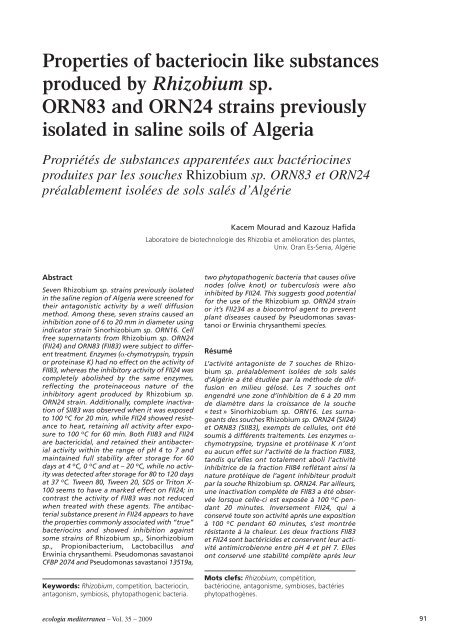Vol. 35 – 2009 - Ecologia Mediterranea - Université d'Avignon et des ...
Vol. 35 – 2009 - Ecologia Mediterranea - Université d'Avignon et des ...
Vol. 35 – 2009 - Ecologia Mediterranea - Université d'Avignon et des ...
Create successful ePaper yourself
Turn your PDF publications into a flip-book with our unique Google optimized e-Paper software.
Properties of bacteriocin like substances<br />
produced by Rhizobium sp.<br />
ORN83 and ORN24 strains previously<br />
isolated in saline soils of Algeria<br />
Propriétés de substances apparentées aux bactériocines<br />
produites par les souches Rhizobium sp. ORN83 <strong>et</strong> ORN24<br />
préalablement isolées de sols salés d’Algérie<br />
Abstract<br />
Seven Rhizobium sp. strains previously isolated<br />
in the saline region of Algeria were screened for<br />
their antagonistic activity by a well diffusion<br />
m<strong>et</strong>hod. Among these, seven strains caused an<br />
inhibition zone of 6 to 20 mm in diam<strong>et</strong>er using<br />
indicator strain Sinorhizobium sp. ORN16. Cell<br />
free supernatants from Rhizobium sp. ORN24<br />
(FII24) and ORN83 (FII83) were subject to different<br />
treatment. Enzymes (α-chymotrypsin, trypsin<br />
or proteinase K) had no effect on the activity of<br />
FII83, whereas the inhibitory activity of FII24 was<br />
compl<strong>et</strong>ely abolished by the same enzymes,<br />
reflecting the proteinaceous nature of the<br />
inhibitory agent produced by Rhizobium sp.<br />
ORN24 strain. Additionally, compl<strong>et</strong>e inactivation<br />
of SII83 was observed when it was exposed<br />
to 100 o C for 20 min, while FII24 showed resistance<br />
to heat, r<strong>et</strong>aining all activity after exposure<br />
to 100 o C for 60 min. Both FII83 and FII24<br />
are bactericidal, and r<strong>et</strong>ained their antibacterial<br />
activity within the range of pH 4 to 7 and<br />
maintained full stability after storage for 60<br />
days at 4 o C, 0 o C and at <strong>–</strong> 20 o C, while no activity<br />
was d<strong>et</strong>ected after storage for 80 to 120 days<br />
at 37 o C. Tween 80, Tween 20, SDS or Triton X-<br />
100 seems to have a marked effect on FII24; in<br />
contrast the activity of FII83 was not reduced<br />
when treated with these agents. The antibacterial<br />
substance present in FII24 appears to have<br />
the properties commonly associated with “true”<br />
bacteriocins and showed inhibition against<br />
some strains of Rhizobium sp., Sinorhizobium<br />
sp., Propionibacterium, Lactobacillus and<br />
Erwinia chrysanthemi. Pseudomonas savastanoi<br />
CFBP 2074 and Pseudomonas savastanoi 1<strong>35</strong>19a,<br />
Keywords: Rhizobium, comp<strong>et</strong>ition, bacteriocin,<br />
antagonism, symbiosis, phytopathogenic bacteria.<br />
ecologia mediterranea <strong>–</strong> <strong>Vol</strong>. <strong>35</strong> <strong>–</strong> <strong>2009</strong><br />
two phytopathogenic bacteria that causes olive<br />
no<strong>des</strong> (olive knot) or tuberculosis were also<br />
inhibited by FII24. This suggests good potential<br />
for the use of the Rhizobium sp. ORN24 strain<br />
or it’s FII234 as a biocontrol agent to prevent<br />
plant diseases caused by Pseudomonas savastanoi<br />
or Erwinia chrysanthemi species.<br />
Résumé<br />
Kacem Mourad and Kazouz Hafida<br />
Laboratoire de biotechnologie <strong>des</strong> Rhizobia <strong>et</strong> amélioration <strong>des</strong> plantes,<br />
Univ. Oran Es-Senia, Algérie<br />
L’activité antagoniste de 7 souches de Rhizobium<br />
sp. préalablement isolées de sols salés<br />
d’Algérie a été étudiée par la méthode de diffusion<br />
en milieu gélosé. Les 7 souches ont<br />
engendré une zone d’inhibition de 6 à 20 mm<br />
de diamètre dans la croissance de la souche<br />
« test » Sinorhizobium sp. ORN16. Les surnageants<br />
<strong>des</strong> souches Rhizobium sp. ORN24 (SII24)<br />
<strong>et</strong> ORN83 (SII83), exempts de cellules, ont été<br />
soumis à différents traitements. Les enzymes αchymotrypsine,<br />
trypsine <strong>et</strong> protéinase K n’ont<br />
eu aucun eff<strong>et</strong> sur l’activité de la fraction FII83,<br />
tandis qu’elles ont totalement aboli l’activité<br />
inhibitrice de la fraction FII84 reflétant ainsi la<br />
nature protéique de l’agent inhibiteur produit<br />
par la souche Rhizobium sp. ORN24. Par ailleurs,<br />
une inactivation complète de FII83 a été observée<br />
lorsque celle-ci est exposée à 100 o C pendant<br />
20 minutes. Inversement FII24, qui a<br />
conservé toute son activité après une exposition<br />
à 100 o C pendant 60 minutes, s’est montrée<br />
résistante à la chaleur. Les deux fractions FII83<br />
<strong>et</strong> FII24 sont bactérici<strong>des</strong> <strong>et</strong> conservent leur activité<br />
antimicrobienne entre pH 4 <strong>et</strong> pH 7. Elles<br />
ont conservé une stabilité complète après leur<br />
Mots clefs: Rhizobium, compétition,<br />
bactériocine, antagonisme, symbioses, bactéries<br />
phytopathogènes.<br />
91
















